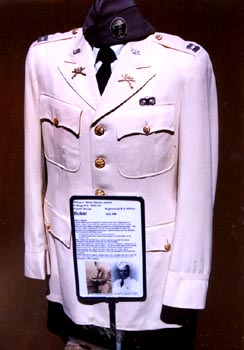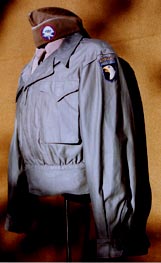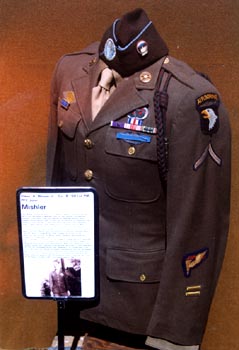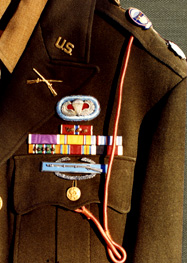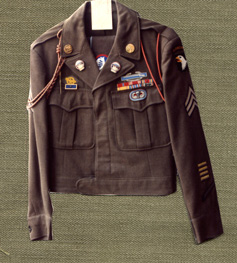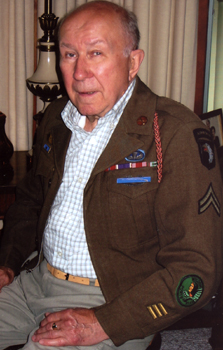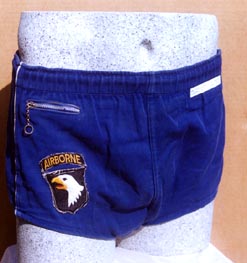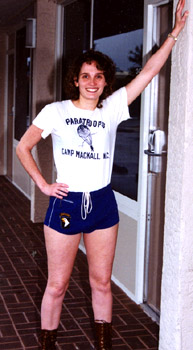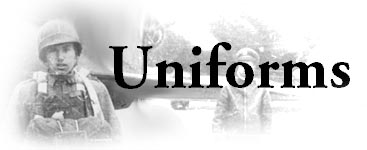

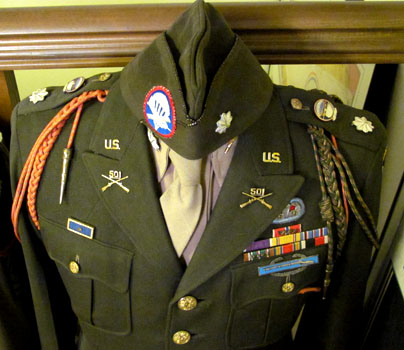
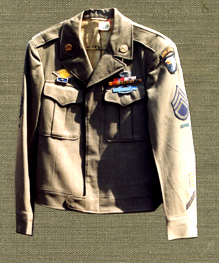
Of all items of military apparel retained by WW2 vets, the most common is the Eisenhower jacket, commonly called an "Ike" jacket. The example at left, is typical of a 101st trooper who went all through the major campaigns. This specimen belonged to Walt Kawalek of Co.'D' 502 PIR. Of course he wears the Combat Infantryman's Badge (CIB), which paratroopers wore below the wings until mid 1945. His wings have no regimental background behind them(wear of the 502 oval was quite limited), and his ribbons include the Bronze Star, Purple Heart with a cluster indicating 2 wounds, Good Conduct Medal, American Campaign Ribbon, and ETO ribbon with four campaign stars and a bronze arrowhead. The arrowhead is for spearheading the Normandy and Holland invasions. Although he was entitled to more than one, only one arrowhead was worn.
At the collar are brass dics, indicating Infantry service with a blue Presidential Citation ribbon and cluster on the right chest (Normandy and Bastogne) and a 'ruptured duck' Honorable Discharge patch above the unit citation ribbon. Visible on the sleeves are staff sergeant chevrons, as well as the horizontal, green combat leadership strips for EMs. A single diagonal 'hashmark' on the left cuff indicates 3 years service in the Army.
Probably because the 4 pocket blouse was discontinued in April, 1945, more vets seem to have retained the Ike jacket than any other garment.
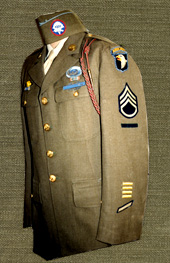
This is a typical early 4 pocket Class 'A' blouse, worn for dress occasions and walking-out. It belonged to Staff Sgt Willard Meeker, who was an original member of B/327th GIR. Bill went through TPS at Ft Benning and although a qualified jumper, was assigned directly to B/327th. He thus wears jump wings, although he entered Normandy by sea and Holland by Glider. Bill was eligible to wear both Glider and Parachute wings, but wearing of both was prohibited at the time, so Bill opted to wear his jump wings on a 2 shade blue wing oval. Bill's left shoulder bears a Belgian Fourregere lanyard for Bastogne, and a Type 7 eagle SSI, sewn with x shaped blue stitching by a former civilian tailor in his company. Four 'Hershey Bars' and a hashmark on his lower left cuff indicate 2 years overseas and 3 years in the Army. Infantry collar brass, an ETO ribbon, Presidential Unit Citation, and Ruptured Duck discharge patch complete the insignia.
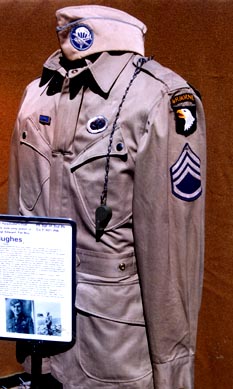
This early M41 "Coat, Parachute Jumpers", was issued to Sgt Ed 'Fat Boy' Hughes of 2d plt F/501 at Camp Toccoa, GA in late 1942. Not realizing it was an earlier version of the M42 jump jacket, Ed thought it was a factory defect and saved it for special occasions. He liked being different and appreciated its uniqueness, wearing it only at formations and on special occasions. Note the narrow, single snap pocket flaps. As in early M42 jackets, the snaps and zipper are made of brass. The pockets, chest, and back lack the expandible bellows quality of the later M42 jacket. Most of the belt is sewn flat against the waist and a snap on the belt supplements the metal buckle. After VE-day, Ed instructed at TPS, Ft Benning, and added the concentric white, red, and blue wing background of the 1st Parachute Training Regiment.
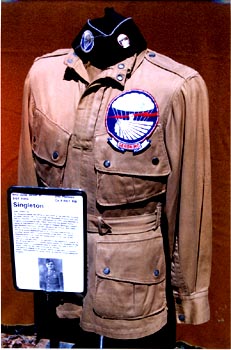
This M42 jacket was worn by Elmo Singleton of New Albany, IN, who served in Hughes' platoon as mortar sgt. Typical of jump jackets worn in the states by 501st men, it has a Geronimo pocket patch on the left chest, overlapping the pocket flap. (Some vintage photos show 501st men wearing the pocket patch on the right chest). The unusual thing about this jacket is that the cuffs were put on the wrong arms at the factory, causing the two wrist snaps to be at the front of the wrist on each sleeve.
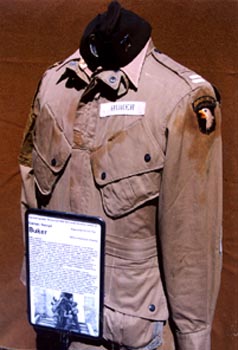
Captain George Buker, the Regimental S-2 Officer of the 502 PIR, wore this gas-impregnated, reinforced M42 jacket in Normandy. It bears a
white name tape on the left chest, as well as officer rank bars
made of sewn suspension line strips ( see Simmons' Jacket on page 2), and a round-domed Type 6 eagle patch, with red tongue. A photo of Buker wearing this very jacket can be seen on page 141 of 'Vanguard of the Crusade'. After WW2, George settled on the west coast with his English bride, and wore out the matching rigger-modified trousers while fishing. This officers' White Dinner Jacket
also belonged to Captain George Buker. When Buker arrived at the 502 Regiment in 1942, Colonel George van Horn Moseley gave him the standard instructions to all new officers joining the 502 PIR: "Subscribe to Infantry Journal magazine, and equip yourself with a White Dinner Jacket, for social affairs at the Officers' Club." The postwar examples I've seen of these jackets are of a thicker white material, and in the 1950's they were discontinued in favor of the Navy Blue dinner tuxedos, still in use. This jacket is displayed with an officers' 'Pink' overseas cap, as I don't have a white one-there was a white overseas cap made to match this jacket. Visible are the set of '502' officers' numbered lapel rifles.
